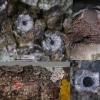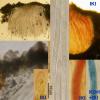
17-12-2025 18:35
 Michel Hairaud
Michel Hairaud
Bonjour à tous/Hi to everyone I am passing along

15-12-2025 15:48
 Danny Newman
Danny Newman
Melanospora cf. lagenaria on old, rotting, fallen

15-12-2025 15:54
 Johan Boonefaes
Johan Boonefaes
Unknown anamorph found on the ground in coastal sa

15-12-2025 21:11
 Hardware Tony
Hardware Tony
Small clavate hairs, negative croziers and IKI bb

15-12-2025 07:09
 Danny Newman
Danny Newman
indet. Rutstroemiaceae sp. on unk. fallen leavesMc

15-12-2025 07:05
 Danny Newman
Danny Newman
Pseudosclerococcum golindoi (det: Zotto)near Cosb

15-12-2025 11:49
 Danny Newman
Danny Newman
ITS sequences from the following two collections B

15-12-2025 12:34
 Danny Newman
Danny Newman
indet. Rhytismataceae on oak leafnear Purchase Roa
Ostropales indet. 2
Hans-Otto Baral,
03-10-2009 18:22
 Here is the second one. This has an inamyloid hymenium (like Ostropa and Robergea), but the spore sheath is very distinctly hemiamyloid!
Here is the second one. This has an inamyloid hymenium (like Ostropa and Robergea), but the spore sheath is very distinctly hemiamyloid!N of Digne, Quercus pubescens branch 10 mm thick. Sp. ca. 300 µm long, *2.5-3.2 µm wide, cells 8-8 µm long, lipid content 1.5-2.5. Asci and whole hymenium inamyloid, but spores in dead state (sometimes also living?) IKI 2rr, after shortly boiling IKI bright blue.
Zotto
Gernot Friebes,
04-10-2009 14:48
Re:Ostropales indet. 2
Hi Zotto,
could it be Schizoxylon albo-atrum? At least this is my outcome with the key of Schizoxylon by Martha Sherwood.
Best wishes,
Gernot
could it be Schizoxylon albo-atrum? At least this is my outcome with the key of Schizoxylon by Martha Sherwood.
Best wishes,
Gernot
Hans-Otto Baral,
04-10-2009 23:15

Re:Ostropales indet. 2
Hi Gernot
thanks, that's a good idea! Sherwoods illustration on p. 112 fits quite well. The ascospore cells she gave as 4-5 x 2 µm, while I measured 5-8 x 2.5-3.2 µm in the living state (sorry for my error above). It is a pity that we do not know whether the spores are also hemiamyloid in Sherwood's material, especially Rehm's type. Sherwood says for the paraphyses J- or faintly J+ blue, but we must know that she used Melzer, and a hemiamyloid hymenium like in my Ostropales indet. 1 would be in Melzer just like that, J- or faintly blue. In one of her material of alboatrum (from Oregon) she reported a strongly amyloid epithecium. And I do not understand why she says "apparently common" but cites only 7 collections.
Zotto
thanks, that's a good idea! Sherwoods illustration on p. 112 fits quite well. The ascospore cells she gave as 4-5 x 2 µm, while I measured 5-8 x 2.5-3.2 µm in the living state (sorry for my error above). It is a pity that we do not know whether the spores are also hemiamyloid in Sherwood's material, especially Rehm's type. Sherwood says for the paraphyses J- or faintly J+ blue, but we must know that she used Melzer, and a hemiamyloid hymenium like in my Ostropales indet. 1 would be in Melzer just like that, J- or faintly blue. In one of her material of alboatrum (from Oregon) she reported a strongly amyloid epithecium. And I do not understand why she says "apparently common" but cites only 7 collections.
Zotto


